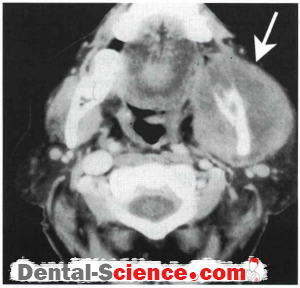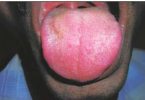Malignant Fibrous Histiocytoma
Epidemiology
Malignant fibrous histiocytoma was uncommonly reported before the 1 970s. Since then, this tumor has become the most frequently reported soft tissue sarcoma in most major institutions.
About 3 to 1 0% of all malignant fibrous histiocytoma occur in the head and neck.
There is no sex predilection and the tumor occurs most frequently in adults 50 to 60 years of age.
Clinical Findings
Patients usually present with a large mass, with or without pain.
Symptoms and signs depend on the location of the tumor and compression of surrounding structures.
Pathology
These tumors arise from tissue histiocytes. They grow and invade along fascial planes.
They usually have well-defined margins but are not encapsulated.
The verifying histologic picture is the storiform pattern of fibroblastic and histiocytic cells.
Most tumors show cellular pleomorphism with multiple giant cells
Treatment
The prognosis is poor. There is a very high recurrence rate following surgery.
The tumor is radioresistant and does not respond significantly to chemotherapy.
Tumors also show a high propensity to metastasize
Imaging Findings
CT
Malignant fibrous histiocytoma appears as a well-defined soft tissue mass with moderate contrast enhancement (check the picture).
It may cause erosion of adjacent bony Structures and may spread intracranially via neural foramina
MR
The tumor shows well-defined margins on both T l – and T2-weighted MR images (check the picture).
Malignant fibrous histiocytomas normally enhance following contrast administration.
These tumors usually have moderately increased signal on T2-weighted imaging.
Intracranial spread is best demonstrated on coronal images following the administration of contrast.
Imaging Pearls
Malignant fibrous histiocytoma must be considered in the differential diagnosis of any soft tissue mass involving the masticator space.
The primary treatment is often based on the extent of disease identified on cross-sectional imaging because the full extent of masticator space masses is difficult to determine on clinical examination
The mandibular nerve (CN V3) innervates the muscles of mastication. Because of the proximity of the mandibular nerve to the masticator space, it is important to examine the trigeminal nerve for possible perineural tumor spread in patients with masticaror space malignancy. Retrograde perineural extension may extend through foramen ovale and may infiltrate the cavernous sinus and the gasserian ganglion
ــــــــــــــــــــ► ⒹⒺⓃⓉⒶⓁ–ⓈⒸⒾⒺⓝⓒⒺ ◄ــــــــــــــــــــ









